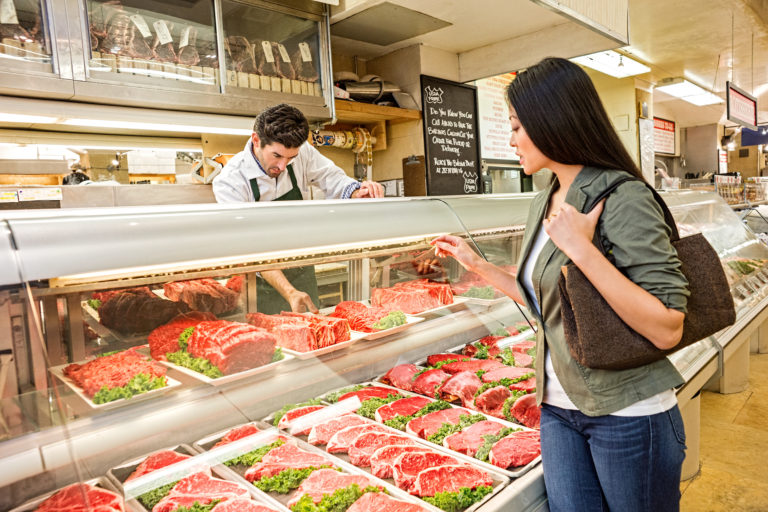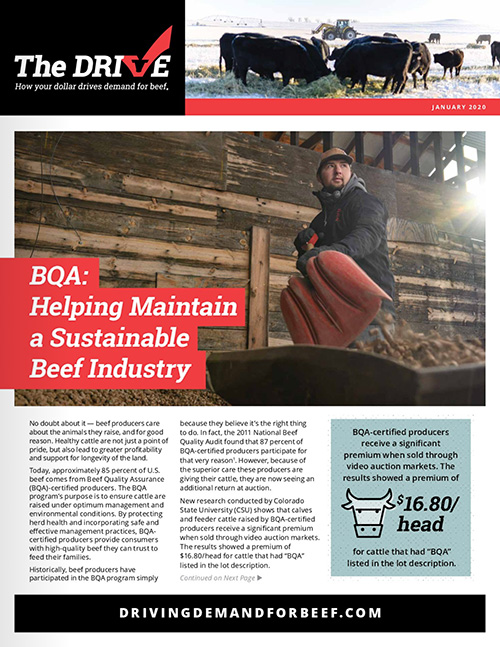
The ‘Beef’ with Meat Substitutes
The conversation around plant-based, alternative proteins and meat substitutes remains top of mind for those active within the beef industry. While some people may believe that meat substitutes are gaining traction in the protein marketplace, data shows consumers are choosing beef over these substitutes and are overall confused about the ingredient composition and alleged benefits from meat substitutes.
In September of 2019, the National Cattlemen’s Beef Association, a contractor to the Beef Checkoff, conducted an online survey to over 1,800 respondents to better understand consumers knowledge of meat substitutes. 44 percent of respondents believed the substitutes were lower in sodium, when the leading meat substitute brands are anywhere between 220 percent to 620 percent higher in sodium than the same size serving of real ground beef. And, 34 percent of respondents believed the substitutes to be less processed than real beef. 1 Meat substitutes are processed and some products contain up to 22 separate ingredients.
This data shows that as an industry there is immense room to grow in educating consumers on beef’s role in a healthy lifestyle. Although there is media buzz around meat substitutes they’re essentially a niche market with a small share of dedicated consumers who fully understand what the product is. Amongst consumers confusion about meat substitutes, beef remains a reliable and authentic source of protein. Sales data revealed 14 billion pounds of beef were sold compared to 700,000 pounds of beef substitutes at retail and foodservice locations. At the end of the day, beef substitutes only comprised half of a percent of the overall market in pounds.2
Because current chatter in the media is all about plant-based, meat substitutes, it is important to keep it in perspective and recognize beef’s excellent performance with consumers. Overall, 2018 retail beef demand showed a 15 percent increase over 2012 figures. While demand factors are very complex, the concept of demand is simple: beef demand relies on sentiment – the trust and loyalty one has for a product. “Driving demand” is the cumulative effort that goes into getting a consumer to think of beef first – positioning beef in the forefront of their minds when they enter a grocery store or restaurant. The Beef Checkoff is building consumer confidence in beef in order to drive overall demand.
How is this happening? By producing safer, higher-quality beef. The Beef Demand Index showed consumers are loving high-quality, USDA-Choice-graded beef products. In fact, today, approximately 80 percent of U.S. beef grades USDA Choice or higher, a 38 percent increase since 2004.
The Beef Checkoff is echoing producers’ dedication to quality in various ways. The latest effort is a full-fledged campaign educating consumers about the checkoff-funded Beef Quality Assurance (BQA) program. Preliminary research showed that simply introducing consumers to the concept of BQA increased their confidence in the safety of beef by 70 percent. It also increased their confidence that animals are treated humanely by 67 percent, and it helped them understand that BQA is an industry-wide effort.3
Another reason consumers gravitate toward beef over meat substitutes is because of something we all know – beef tastes great! “Taste” is the top reason consumers cite when they say they’re planning to eat more beef.4 The checkoff-funded Beef. It’s What’s For Dinner. brand is constantly showcasing new and exciting ways to incorporate beef into meals with recipes and nutritional facts found in digital ads online and in grocery stores across the country.
The Beef Checkoff also dedicates resources to consumer-tracking research in an effort to help identify which proteins consumers are gravitating toward when purchasing food. These metrics help the beef industry identify new market opportunities such as meal kits. According to the 2018 Power of Meat Study, shoppers continue to look for ways to include convenience-focused solutions in their meal plans. 5 Recognizing this niche market opportunity, the Beef Checkoff worked with the American Foods Group to develop a steak-bowl meal kit that contains UDSA Choice beef.
Consumer interests are constantly changing, and to remain successful, the beef industry must respond accordingly. The Beef Checkoff is steadfastly committed to actively participating in conversations about meat substitutes, and it will do so by promoting beef and educating consumers about beef’s unparalleled qualities at every opportunity. At the end of the day, it’s all about driving demand for beef.
- National Cattlemen’s Beef Association Meat Substitute and Brand Understanding study, September 2019.
- IRI, Refrigerated/Frozen Meat Substitutes, 52 weeks ending 6/16/18; IRI/Freshlook, Total US MULO ending 5/28/18; Categorized by VMMeat System; Alternative Proteins at Foodservice Study, Technomic, October 2018; Usage and Volumetric Assessment of Beef in Foodservice, Technomic, December 2017
- 2018 Responsible Beef Exploration
- Consumer Beef Tracker, National Cattlemen’s Beef Association, Q1 2018
- 2018 The Power of Meat, 210 Analytics, Food Marketing Institute, February 2018.
The Beef Checkoff program was established as part of the 1985 Farm Bill. The checkoff assesses $1 per head on the sale of live domestic and imported cattle, in addition to a comparable assessment on imported beef and beef products. States may retain up to 50 cents on the dollar and forward the other 50 cents per head to the Cattlemen’s Beef Promotion and Research Board, which administers the national checkoff program, subject to USDA approval.








































































